This summer is the 70th anniversary of Operation Crossroads, the first postwar nuclear test series. Crossroads is so strange and unusual. 1946 in general ought to get more credit as an interesting year, as I’ve written about before. It was a year in flux, where a great number of possible futures seemed possible, before the apparently iron-clad dynamics of the Cold War fell into place. Crossroads happens right in the middle of the year, and arguably made a pretty big contribution to the direction that we ended up going. Such is the subject of my latest article for the New Yorker‘s Elements blog, “America at the Atomic Crossroads.” Today is the anniversary of the Baker shot, which Glenn Seaborg dubbed “the world’s first nuclear disaster.”
There are a lot of things that make Crossroads interesting to me. The bomb was still in the hands of the Manhattan Project. The Atomic Energy Act of 1946 had not yet been signed into law (Truman would sign it in August, and it would go into effect in January 1947), so the Atomic Energy Commission did not yet exist.
There were these amazing interservice rivalry aspects: the whole backdrop is a Navy vs. Army tension. The Manhattan Project, and the Army Air Forces, had gotten all the glory for the bomb. The Navy didn’t want to be left out, or seen as irrelevant. Hence them hosting a big test, and glorying in the fact that a Nagasaki-sized atomic bomb doesn’t completely destroy a full naval squadron. (Which was no surprise to anybody on the scientific or military side of things.)
The US had only about 10 atomic bombs at the time. So they expended about 20% of their entire nuclear arsenal on these tests, for relatively little military knowledge gained. The Los Alamos scientists were pretty lukewarm on the whole operation — it just didn’t seem like it was getting them much. One wonders, if the bomb had not still be under military control, whether it would have happened.

Photograph of the early mushroom cloud of Crossroads Able by LIFE photographer Frank Scherschel, with a darkened filter to compensate for the brightness of the flash. Source.
The first shot, Able, was something of a flub. The fact that it missed its target meant that for public relations purposes it was seen as very ineffective, but it also means that their scientific observations were largely pretty useless. In fact, it missed its target and blew up over one of the main instrumentation ships.
If you read most sources about Crossroads they will say that the source of the Able miss was undetermined, but if you dig down a little deeper you find some pretty plausible solutions (and the reason why the official verdict was “undetermined”). Paul Tibbets, the captain of the Enola Gay and overall head of the atomic delivery group, was pretty clear that it was human error. He said that even before the shot they realized that the crew of the B-29 which dropped it, Dave’s Dream, had gotten bad information about the weather conditions, but that they ignored attempts at correction. Tibbets would re-run (with a dummy bomb) the drop with the correct information (and got very close to the target), and also re-ran it with the wrong information (which missed by nearly the same amount as the Able shot). But the USAAF really didn’t want to throw their bombardier and plane crew under the bus. So they hinted it might be a problem with the ballistics of the weapon (which were indeed a bit tricky), which infuriated the Manhattan Project officials. Anyway, everyone seems to have been satisfied by just saying they couldn’t figure out where the error was. But Tibbets’ account seems most plausible to me. 1
Crossroads was not secret operation, though there was much classified about it. There were full-spread articles about its purpose in national news publications both before and after its tests. There was probably no test series so publicly conducted by any nuclear power — announced well in advance, covered by the press in real-time, and then heavily publicized afterwards. The fact that the Soviets were invited to a US nuclear test operation (something that would not happen again until the late-1980s) opens up whole other dimensions.
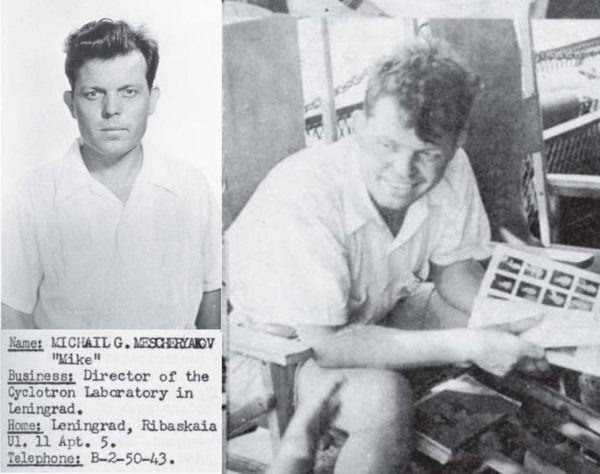
Mikhail Meshcheryakov in 1946. At right he is on the USS Panamint, at the Crossroads test. Source: Mikhail Grigorivich Meshcheryakov, on the 100th-anniversary of his birth (Dubna, 2010).
The Soviets had three observers at the test: Professor Semyon P. Aleksandrov, a geologist who had worked on the prospecting of uranium; Mikhail G. Meshcheryakov, an experimental physicist; and Captain Abram M. Khokhlov, who attended as a member of the international press corps (he wrote for the Soviet periodical Red Fleet). I found a really amusing little anecdote about the Soviet observers from one of the men who worked the Manhattan Project security detail on Crossroads: Aleksandrov was someone they knew already (he was a “dear old geologist”), but Meshcheryakov was someone “whose name was known, but no one had met personally leading some of us to support he was really an NKVD agent watching Aleksandrov.”
I found nothing in the Russian source materials (mentioned below) that would indicate that Meshcheryakov was NKVD, though he was definitely the one who wrote up the big report on Crossroads that was given to Beria, who summarized it for Stalin. Meshcheryakov’s report is not among the declassified documents released by the Russians, so who knows if it has any political commentary on Aleksandrov in it. Meshcheryakov ended up having a rather long and distinguished physics career in the USSR, though there is almost no English-language discussion of him on the Internet. Aleksandrov, the “dear old geologist,” was actually a major Soviet big-wig in charge of mining operations, which at that time meant he was high in the Gulag system, which was run by the NKVD. For what it’s worth. 2
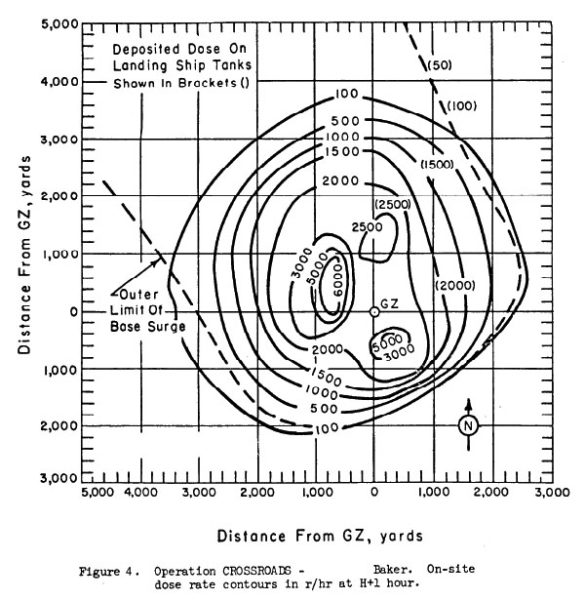
Radiation from the Crossroads Baker shot — the radiation went up with the cloud, and then collapsed right back down again with it, resulting in a very limited extent of radiation (the entire chart represents only 4.5 miles on each axis), but very high intensities. Chart source: DNA 1251-2-EX. Collapsed cloud picture source: Library of Congress.
It was also something of the real birth of “atomic kitsch.” There are some examples from before Crossroads, but there is just a real flourishing afterwards. It seems to have taken a year or so after Hiroshima and Nagasaki for enough time to have passed for Americans to start to regard nuclear weapons entirely frivolously. With Crossroads in particular, a deep connection between sex and death (Freud’s favorites) circled around the bomb. This is where we start to see the sorts of activities that would later result in the “Miss Atomic Bomb” contests, the release of the really kitchy songs, and, of course, the Bikini swimsuit, named after the “atomic bomb island,” as LIFE put it.
The key fulcrum of my article is a meditation on the “crossroads” metaphor, and I should probably note that it was, to some degree, intentional. Vice Admiral William Blandy was reported by the New York Times to have told Congress, that the name was chosen for its “possible significance,” which the Times writer interpreted to mean “that seapower, airpower, and perhaps humanity itself — were at the crossroads.” 3
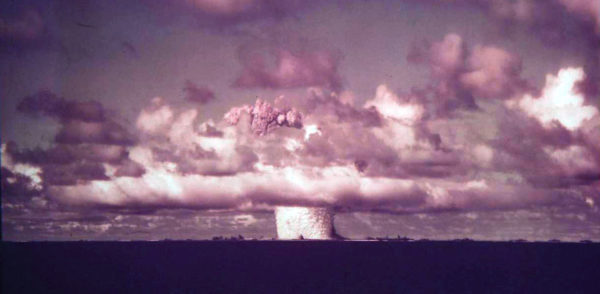
An unusual color (but not colorized!) photograph of the Crossroads Baker detonation, from LIFE magazine. Source.
What’s interesting to me is that Blandy clearly saw some aspects of the “crossroads,” but there was much he couldn’t have seen — the atomic culture, the arms race, the contamination, the nuclear fears. He knew that “crossroads” was a good name for what they were doing, but it was an even better name than he could have known, for both better and worst.
As before, I wanted to take a moment to give some credit/citation information that wasn’t workable into the New Yorker blog post (where space, and thus academic nicety, is constrained).
The best overall source on Crossroads, which I found invaluable, is Jonathan Weisgall’s Operation Crossroads: The Atomic Tests at Bikini Atoll (Naval Institute Press, 1994). Weisgall has been a legal counsel on behalf of the Marshallese, and his book is just a wealth of information. I was pleased to find a few things that he didn’t have in his book, because it’s a really tough challenge given how much work he put into it. If you find Crossroads interesting, you have to read Weisgall.
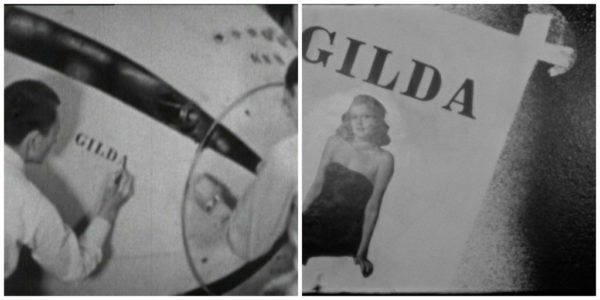
Rita Hayworth on the Crossroads Able bomb, “Gilda.” Photo courtesy Los Alamos National Laboratory, via Peter Kuran and Bill Geerhart.
Bill Geerhart, who writes the excellent blog CONELRAD Adjacent (and is the one behind the Atomic Platters series of Cold War songs), has done some really wonderful work on the cultural aspects of Crossroads over the years. His posts on the mushroom cloud cake, and his sleuthing regarding the Rita Hayworth connection, are amazing and worth reading in their entirety. Peter Kuran, the visual effects wizard who made the documentary Trinity and Beyond, among other films and works, was very helpful in providing recently-declassified imagery of the Crossroads bombs, including photos (which I first saw on Geerhart’s blog) of the Rita Hayworth image on the side of the bomb themselves. (I will be writing more about Kuran and his work in the near future…)
Holly Barker’s Bravo for the Marshallese (Thomson/Wadsworth, 2004), is immensely useful as an anthropologist’s view of the Marshallese people and their experiences after the test. My invocation of the Marshallese language for birth defects comes directly from Barker’s book, pages 81 and 106-107. It is a powerful, disturbing section of the book.
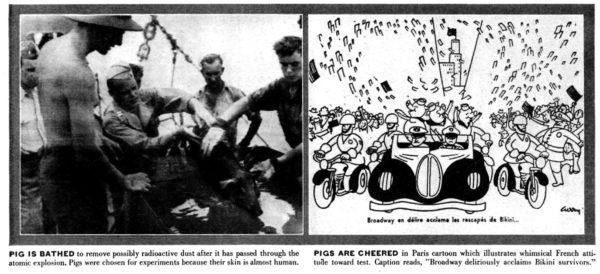
Selection from Life magazine’s coverage of Crossroads — two visions of the animal testing. Source.
Most of the information I got about the Soviet view of Crossroads comes from the multi-volume Atomniy Proekt SSSR document series released by the Russian Federation. I had the full set of these before it was cool, but now Rosatom has put them all online. Scholars have been picking over these for awhile (I have written on them once before), I haven’t seen anybody use the particular documents relating to Crossroads before, but you in Tom (Volume) 2, Kniga (Book) 6, the documents I found most useful were 44 (pp. 130-132), 48 (135-136), 50 (137), 76 (184-188), and 106 (246-248). They show the picking of the delegation of observers, brief biographies of the observers, a summary of Meshcheryakov’s report (his full 110-page report on Crossroads is not included), and some later aspects of Meshcheryakov’s involvement with the planning of the first Soviet nuclear test in 1949 (in which his Bikini experience was offered up as his bonafides).
The other really unusual little source I used for my article is the letter from Percy Bridgman. The letter was sent from Bridgman to Hans Bethe, who relayed it to Norris Bradbury at Los Alamos, who sent it to General Groves. You can read it here. I have been sitting on it for a long time — I almost wrote a blog post about it in 2012, but decided not to for whatever reason. When I worked at the American Institute of Physics I had an opportunity to poke around Bridgman’s life and writings a bit, and he’s really an interesting character. He was the one at Harvard who served as J. Robert Oppenheimer’s physics advisor, and his own work on high-pressure physics not only won him the Nobel Prize of 1946 (which is a nice coincidence for the Crossroads article), but also was used (and is still classified, as far as I can tell) on the Manhattan Project (they seem to have sent him plutonium samples, so you can imagine the kind of work he was doing and why it might still be classified — almost everything on plutonium under high pressures is classified in the United States).
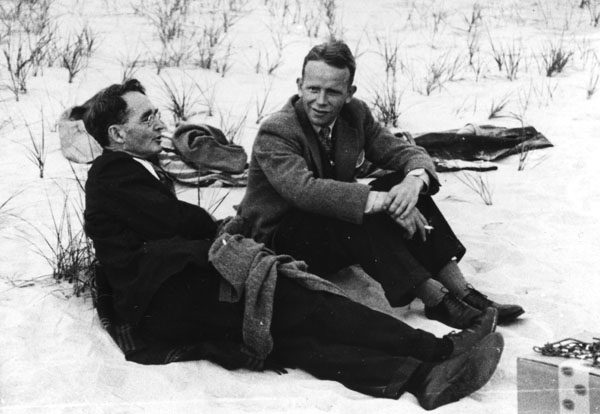
Percy W. Bridgman (L) talking with Harvard colleague (and future Trinity test director) Kenneth Bainbridge on a Massachusetts beach, 1934. Source: Emilio Segrè Visual Archives, American Institute of Physics.
Bridgman gave a number of talks associated with his Nobel Prize that really tried to get at the heart of what the effects of World War II would be for physics as a discipline. He was very much afraid that Big Science (which hadn’t yet been given that name) would really destroy work like his own, which he saw as small-scale, individual, and not focused on particular applications. He was also very interested in topics related to the philosophy of science, something that a lot of modern-day practicing physicists openly disdain. His Wikipedia page gives a nice, brief overview of his life, and even touches on the poignant circumstances of his death. 4.
- This is discussed at length in Jonathan Weisgall’s Operation Crossroads, pp. 201-204.[↩]
- The account of the security officer is Charles I. Campbell, A Questing Life: The Search for Meaning (New York: iUniverse, 2006). This appears to be a self-published memoir, the sort of thing one would never run across without Google Books. On Aleksandrov’s Gulag connections (which seem plausible given his uranium connections), see this page on his Hero of Socialist Labor award. One of the few English-language articles on Meshcheryakov is available here.[↩]
- Sidney Shallet, “Test Atomic Bombs to Blast 100 Ships at Marshall Atoll,” New York Times (25 January 1946), 1. Blandy’s full quote on the name from the testimony: “The schedule of target dates for this operation, which will be known by the code word ‘CROSSROADS’—and I would like to explain that we have chosen that merely for brevity in dispatches and other communications, and we chose it with an eye to its possible significance—now calls for the first test to be accomplished early in May, over target ships at an altitude of several hundred feed.” A lot of the sources about Crossroads include Shallet’s bit about “perhaps humanity itself” as a quote of Blandy’s, but it’s not in the transcript that I can see. Hearing before the Special Committee on Atomic Energy, United States Senate, Pursuant to S. Res. 179, Part 4, 79th Congress, 2nd Session (24 January 1946), on 457.[↩]
- The citation for the Bridgman letter is: Percy W. Bridgman to Hans Bethe, forwarded by Norris Bradbury to Leslie Groves via TWX (13 March 1946), copy in the Nuclear Testing Archive, Las Vegas, NV, document NV0128609.[↩]



With regard to Mescheryakov, there’s a fair amount of information in, unsurprisingly, Russian. E.g.,
https://tinyurl.com/zmnnl53 (Vikipediya)
and
http://www.biblioatom.ru/founders/meshcheryakov_mikhail_grigorevich/
The second contains the following concerning the Crossroads operation:
Советскими наблюдателями стали М.Г. Мещеряков и С.П. Александров, горный инженер, сотрудник МГБ.
Soviet observers were M.G. Meshcheryakov and S.P. Aleksandrov, a mining engineer [and] member of the MGB [Ministry of State Security].
Right — I found loads on him in Russian. My Russian is pretty плохо but fortunately it is usually enough to get by for this sort of thing.
Thank you for an amazing post and I especially appreciate you pointing out the Soviet atomic history books. Now that they are all online and publically available maybe more translations will come forth.